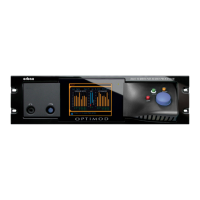1-20
INTRODUCTION ORBAN MODEL 8685
spread over a larger number of critical bands (about 1/3 octave). This is
called loudness summation.
4. Temporal integration: As its duration increases, a sound at a given
level appears progressively louder until its duration exceeds about 200
milliseconds, at which point no further loudness increase occurs.
Bauer and Torick used the results of this research to create a loudness
level meter with eight octave-wide filters, each of which covers three
critical bands. (B & T did not use one filter per critical band because this
would have made the meter, which was realized using analog circuitry,
prohibitively expensive.) Each filter feeds a full-wave rectifier and each
rectifier feeds a nonlinear lowpass filter that has a 10 ms attack time and
a 200 ms release time, somewhat like the sidechain filter in an AGC. This
models the “instantaneous loudness” perception mechanism in the ear.
Instantaneous loudness is not perceived directly but is an essential part of
the total loudness model.
To map the instantaneous loudness to perceived short-term loudness, the
outputs of each of the nonlinear lowpass filters are arithmetically
summed with gains chosen to follow the 70 phon equal-loudness curves
of the ear as determined by Bauer and Torick’s research. The sum is ap-
plied to a second, slower nonlinear lowpass filter. This has an attack time
of 120 ms and a release time of 730 ms. Along with the eight nonlinear
lowpass filters following the individual filters, this filter models temporal
integration and maps it to the visual display. Meanwhile, the arithmetic
addition models loudness summation.
The internationally accepted unit of subjective loudness is the sone. With
a sinewave, 40 phons = 1 sone. A doubling of sones corresponds to a
doubling of loudness. However, because broadcasters were accustomed
to working in decibel units, Jones and Torick chose to map loudness on a
LED ladder display encompassing –20 to +5 dB in 0.5 dB increments, with
the understanding that the perceived loudness doubles every 10 dB at
loudness levels typically heard by broadcast audiences.
The J & T meter is monophonic. Psychoacoustic studies indicate that
when multiple acoustic sources are present in a room, loudness is most
accurately expressed by summing the power in the sources. For example,
driving two loudspeakers with identical program produces 3 dB higher
loudness than a single speaker produces. Therefore, to extend the J & T
algorithm to surround reproduction, we implement one eight-filter fil-
terbank for each channel and compute RMS sums of the outputs of cor-
responding filters in each channel before these sums are applied to the
eight nonlinear lowpass filters. As in the monophonic J & T algorithm,
the sum of these lowpass filters drives a second nonlinear filter, which
drives the display.
Test Modes
Calibrated Bypass Test Mode
A BYPASS Test Mode is available to transparently pass line-up tones generated ear-
lier in the system. It will also pass program material, with no gain reduction or pro-
tection against overmodulation. It can transparently pass any line-up tone applied
to its input up to about 130% output modulation, at which point clipping may oc-
cur.

